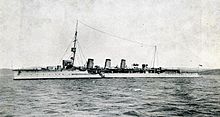Spanish cruiser class
Méndez Núñez after her 1944 refit
Class overview Name Blas de Lezo classBuilders Sociedad Española de Construcción Naval in Ferrol Operators Spanish Navy Preceded by Navarra Succeeded by Almirante Cervera -class cruiserIn commission 1924–1963 Completed 2 Lost 1 Retired 1 General characteristics Displacement
4,780 long tons (4,860 t) standard
6,230 long tons (6,330 t) full load
Length 462 ft (141 m) Beam 46 ft (14 m) Draught 14 ft 4 in (4.37 m) Propulsion 4 shafts, Parsons Type geared turbines, 12 Yarrow Type boilers, 45,000 hp Speed 29 knots (54 km/h) Range 5,000 nmi (9,300 km) at 13 kn (24 km/h) Complement 320 Armament
6 × 6-inch (152 mm) guns in single mountings
4 ×47mm guns
12 × 21-inch (533 mm) torpedoes in triple tubes above water
Armour 3 - 2 inch belt, 1 inch deck, 6 inch conning tower
The Blas de Lezo -class cruisersSpanish Navy in the 1920s. The ships were ordered in 1915 but construction proceeded slowly due to material shortages during World War I . The ships were built by Sociedad Española de Construcción Naval in Ferrol and showed considerable British design influence, resembling contemporary British C-class cruisers .
Mendez Nunez was reconstructed into an anti-aircraft cruiser in 1944. She was re-armed with 8 - 120mm Vickers anti-aircraft guns in single mountings, 4 × 2 37mm and 2 × 4 20mm light AA guns of German origin. The superstructure was completely rebuilt and fitted with modern fire control equipment. Two triple banks of torpedo tubes were retained.
Ships
Ship
Launched
Commissioned
Fate
Blas de Lezo 27 July 1922
March 1925
Wrecked 11 July 1932
Méndez Núñez 3 March 1923
1924
Stricken 1963
Blaz de Lezo Blas de Lezo' s shakedown in 1923Profile of Blas de Lezo as she appeared in 1932 Blas de Lezo was named after Admiral Blas de Lezo . In early 1926, she supported the transatlantic flight from Spain to Buenos Aires , Argentina , of a four-man Spanish Air Force crew led by pilot Major Ramón Franco – the brother of future Spanish caudillo Francisco Franco – and including copilot/navigator Captain Julio Ruiz de Alda Miqueleiz in the Dornier Do J Wal ("Whale") flying boat Plus Ultra Cape Finisterre in 1932 and sank in deep water.
Méndez Núñez Profile of Méndez Núñez as she appeared in 1932 Profile of Méndez Núñez as she appeared in 1950 Méndez Núñez was named after Admiral Casto Méndez Núñez . She was based in Equatorial Guinea at the start of the Spanish Civil War and she returned home to fight for the Spanish Republican Navy . In 1939, following the Cartagena Uprising , she was interned in Bizerte and seized by the French authorities. She was later handed to Francoist Spain , serving until 1963.
References
Aviation History , January 2018, p. 57.
Bibliography
Chesneau, Roger, ed. (1980). Conway's All the World's Fighting Ships 1922–1946 . New York: Mayflower Books. ISBN 0-8317-0303-2 Whitley, M. J. (1995). Cruisers of World War Two: An International Encyclopedia . London: Cassell. ISBN 1-86019-874-0 External links
Categories :
Blas de Lezo -class cruiser
Add topic
Text is available under the Creative Commons Attribution-ShareAlike License. Additional terms may apply.
**DISCLAIMER** We are not affiliated with Wikipedia, and Cloudflare.
The information presented on this site is for general informational purposes only and does not constitute medical advice.
You should always have a personal consultation with a healthcare professional before making changes to your diet, medication, or exercise routine.
AI helps with the correspondence in our chat.
We participate in an affiliate program. If you buy something through a link, we may earn a commission 💕
↑
 Méndez Núñez after her 1944 refit
Méndez Núñez after her 1944 refit



